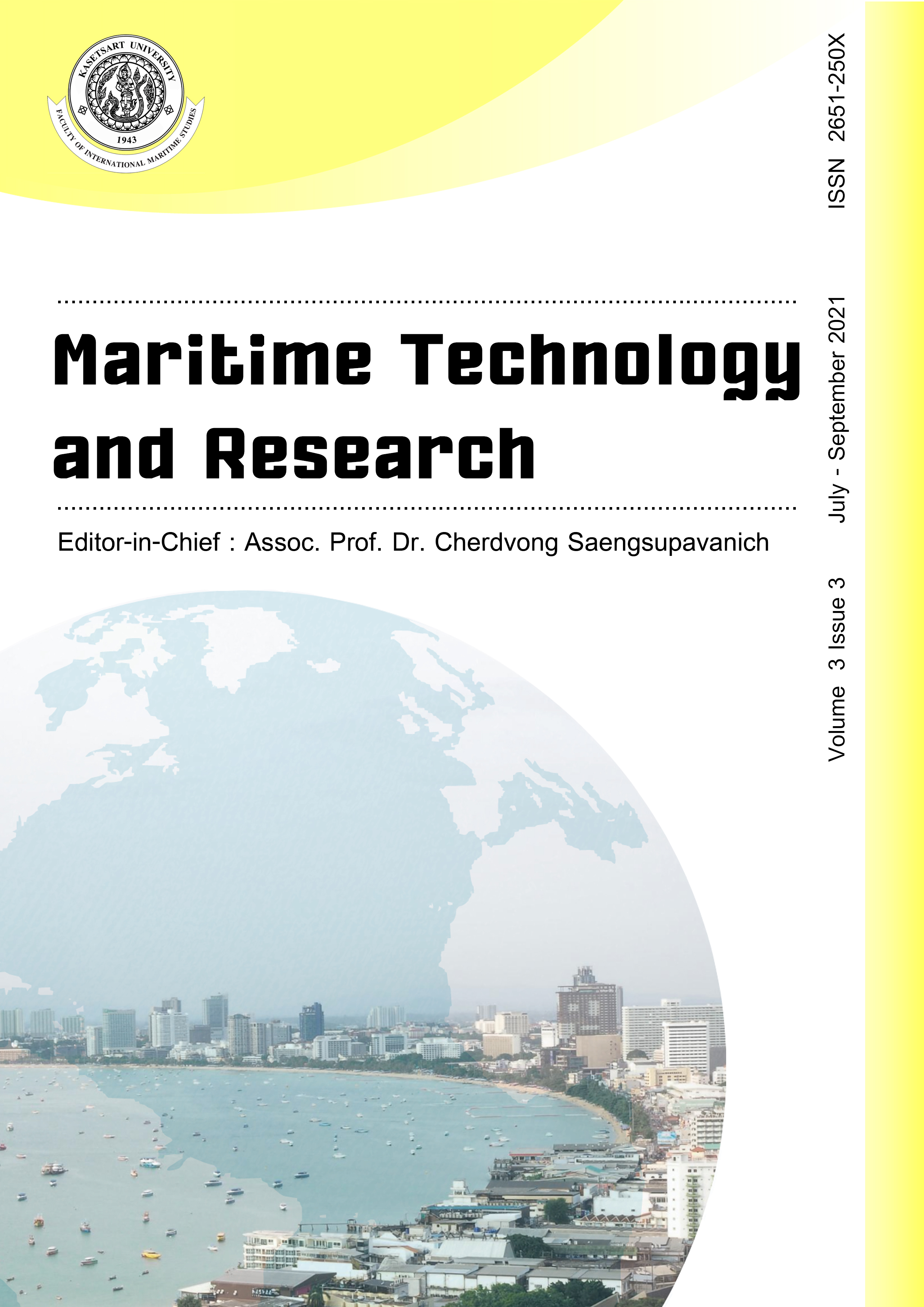The influence of information technology on the implementation of the International Safety Management (ISM) Code: A shift from paper-based to paperless ships
DOI:
https://doi.org/10.33175/mtr.2021.249024Keywords:
Maritime, Safety, Quality assurance, International Safety Management Code, Security, Information technologyAbstract
To provide an international standard for the safe management and operation of ships and for pollution prevention, the International Maritime Organization (IMO) introduced the International Safety Management (ISM) Code (adopted in 1993 and entered in force on 1st July 1998). The Code, through its guidelines and recommendations, provides seafarers (ship’s crew) the course of action for the safety and quality assurance process on ships. Traditionally a paper-based system, the ISM Code is now being digitalized in every aspect to streamline the processes to improve ship operations. This paper presents findings of a review of existing literature available on the world wide web to highlight areas of the Code that have been impacted by technology and the benefits that are being reaped. However, recent cyber attacks on ships and the maritime industry require a discussion on various implications associated with ships becoming increasingly reliant on technology and the advancing digital world. This paper highlights and explains the related implications and suggests strategies to address them.
References
ABS Group. (2020). Marine vessel management software. Retrieved from https://www.abs-group.com/What-We-Do/Software-Solutions/Nautical-Systems-Software
Australian Government. (2006). Marine orders: Part 58. International Safety Management Code. Issue 2. Consolidation No. 1. Australian Maritime Safety Authority (AMSA). Retrieved from https://www.legislation.gov.au/Details/F2006C00466
BIMCO. (2018). The guidelines on cyber security onboard ships. Version 3. https://www.bimco.org/news/priority-news/20180924-cyber-security-survey
Clerck, J. (2017). Digitalizaton, digital transformation: the differences. I-Scoop. Retrieved from https://www.i-scoop.eu/digital-transformation/digitization-digitalization-digital-transformation-disruption
Cosgrave, B. (2018). Electronic certificates for ships: A LOFTY (legal, operations, fraud, trust) analysis (Master’s thesis). World Maritime University.
Crittenden, W., Biel, I., & Lovely III, W. (2019). Embracing digitalization: Student learning and new technologies. Journal of Marketing Education, 41(1), 5-14. doi:10.1177/0273475318820895
Cyber Citadel. (2020). Logistics cybersecurity far from ‘ship shape’. Retrieved from https://www.cybercitadel.com/logistics-far-from-ship-shape
Devereux, M., & Vella, J. (2018). Debate: Implications of digitalization for international corporate tax reform. Intertax, 46(6), 550-559.
DNV GL. (2015). Our ships in the digital world: DNV GL Innovation Day examines shipping in the age of digitalization. Retrieved from https://www.dnvgl.com/news/our-ships-in-the-digital-world-dnv-gl-innovation-day-examines-shipping-in-the-age-of-digitalization-45530
DNV GL. (2020a). Planned maintenance system for technical ship management: Ship manager technical. Retrieved from https://www.dnvgl.com.au/services/planned-maintenance-system-for-technical-ship-management-shipmanager-technical-1509
DNV GL. (2020b). Electronic class and statutory certificates. Retrieved from https://www.dnvgl.com/maritime/electronic-certificates/index.html
DNV GL. (2020c). Digital MRV and DCS reporting streamlines the verification process. Retrieved from https://www.dnvgl.com/expert-story/maritime-impact/Digital-MRV-and-DCS-reporting-streamlines-the-verification-process.html
Ellefsen, A. L., Æsøy, V., Ushakov, S., & Zhang, H. (2019). A comprehensive survey of prognostics and health management based on deep learning for autonomous ships. IEEE Transactions on Reliability, 68(2): 720-740. doi:10.1109/TR.2019.2907402
Ghosh, S. (2017). Can authentic assessment find its place in seafarer education and training? Australian Journal of Maritime & Ocean Affairs, 9(4), 213-226. doi:10.1080/18366503.2017.1320828
Gobble, M. (2018). Digitalization, digitization, and innovation. Research-Technology Management, 61(4), 56-59. doi:10.1080/08956308.2018.1471280
Hagberg, J., Sundstrom, M., & Egels-Zandén, N. (2016). The digitalization of retailing: An exploratory framework. International Journal Retail & Distribution Management, 44(7), 694-712. doi:10.1108/IJRDM-09-2015-0140
Hogg, T., & Ghosh, S. (2016). Autonomous merchant vessels: Examination of factors that impact the effective implementation of unmanned ships. Australian Journal of Maritime & Ocean Affairs, 8(3), 206-222. doi:10.1080/18366503.2016.1229244
Hutchings, S. (2017). Safety management systems. Safety4sea. Retrieved from https://safety4sea.com/safety-management-systems
IHS Markit. (2018). Maritime cyber survey 2018: The results. BIMCO. Retrieved from https://www.bimco.org/news/priority-news/20180924-cyber-security-survey
IMO (International Maritime Organization). (2002). International Safety Management Code: And revised guidelines on implementation of the ISM Code. International Maritime Organization, London.
IMO (International Maritime Organization). (2019a). The International Safety Management (ISM) Code. Retrieved from https://www.imo.org/en/OurWork/HumanElement/Pages/ ISMCode.aspx
IMO (International Maritime Organization). (2019b). Maritime cyber risk. Retrieved from https://www.imo.org/en/OurWork/Security/Pages/Cyber-security.aspx
Johns, M. (2018). Seafarers and digital disruption: The effect of autonomous ships on the work at sea, the role of seafarers and the shipping industry. HSBA (Hamburg School of Business Administration). Hamburg / London.
Kapalidis, K. (2019). Cyber security challenges for the maritime industry. Safety4sea. Retrieved from https://safety4sea.com/cm-cyber-security-challenges-for-the-maritime-industry
Kinthaert, L. (2017). Digital transformation: How will it change the seafarer’s role? Informaconnect. Retrieved from https://informaconnect.com/digital-transformation-how-will-it-change-the-seafarers-role
Lloyd’s Register. (2020). Statutory alert: Use of MARPOL electronic record books. Retrieved from https://info.lr.org/l/12702/2020-09-29/9kc976
Lord, N. (2020). The cost of a malware infection? For Maersk, $300 million. Digital Guardian. Retrieved from https://digitalguardian.com/blog/cost-malware-infection-maersk-300-million
Morley, J., Widdicks, K., & Hazas, M. (2018). Digitalisation, energy and data demand: The impact of internet traffic on overall and peak electricity consumption. Energy Resource & Social Sciences, 38(1), 128-137. doi:10.1016/j.erss.2018.01.018
Nas, S. (2015). The definitions of safety and security. Journal of ETA Maritime Science, 3(2), 53-54. doi:10.5505/jems.2015.42713
Nikulita, O., Nwora, O. & Skaf, Z. (2017). Towards design of prognostics and health management solutions for maritime assets (pp. 122-132). In Proceedings of the International Conference on Through-life Engineering Services 2017.
Ruha, T. (2018). Cybersecurity of computer networks (Thesis, Bachelor’s Degree). Helsinki Metropolia University of Applied Sciences, Helsinki.
Safety4sea. (2020). Maersk line: Surviving from a cyber-attack. Retrieved from https://safety4sea.com/cm-maersk-line-surviving-from-a-cyber-attack
Shipnet. (2020). Planned maintenance system for ships. Retrieved from https://www.shipnet.no/planned-maintenance-system-for-ships/#1576765249087-%200b620a32-4242
Splash. (2020). The cyber imperative: A vessel as one digital ecosystem. Retrieved from https://splash247.com/the-cyber-imperative-a-vessel-as-one-digital-ecosystem
Stag Marine Management. (2018). VDR navigation audit. Retrieved from https://www.stagmarine.com/VDR-navigation-audit.php
Theotokas, I., & Alexopoulos, A. (1998). Safety & quality in the shipping industry: A legal analysis of the ISM Code’s principles & applications. European Research Studies Journal, 1(3), 81-98.
UpKeep. (2020). Planned maintenance systems (PMS)+ 6 features. Retrieved from https://www.onupkeep.com/answers/preventive-maintenance/planned-maintenance-systems
Vandenborn, Y. (2018). Twenty years of the ISM code. Safety4sea. Retrieved from https://safety4sea.com/twenty-years-of-the-ism-code/#:~:text=The%20ISM%20code %20was%20born,its%20539%20passengers%20and%20crew
Wilhelmsen. (2020). DocMap. Retrieved from https://www.wilhelmsen.com/other-services/imtc/courses/information-technology-courses/docmap-course
Downloads
Published
Issue
Section
License
Copyright: CC BY-NC-ND 4.0








